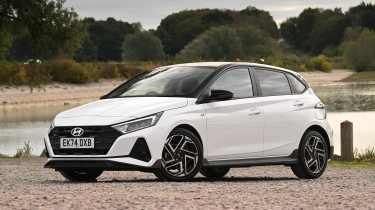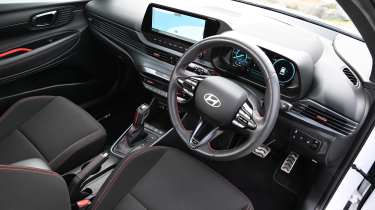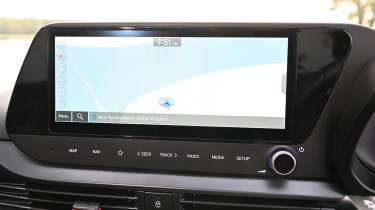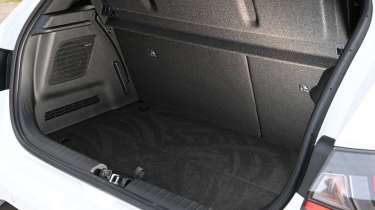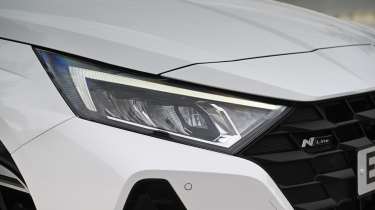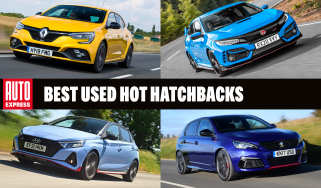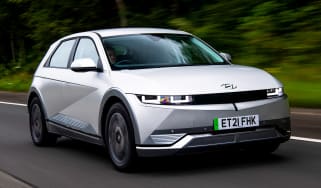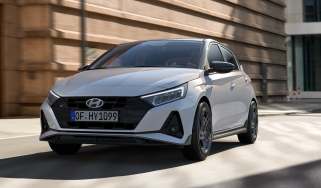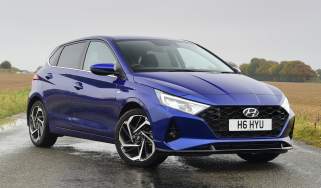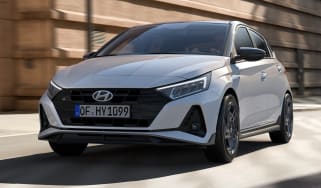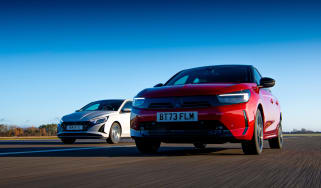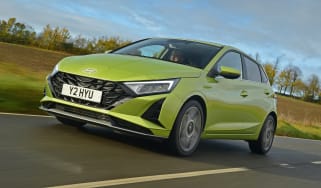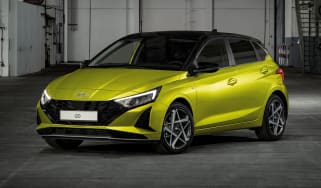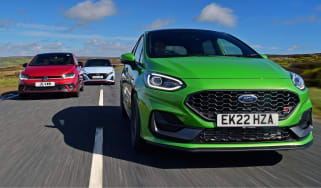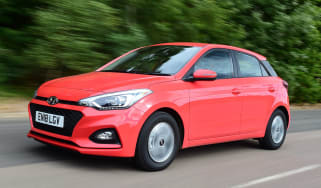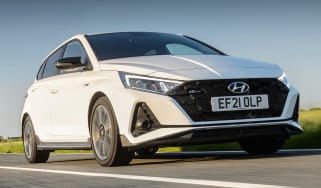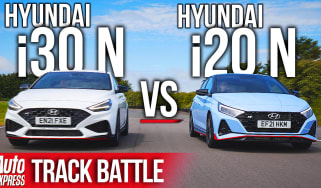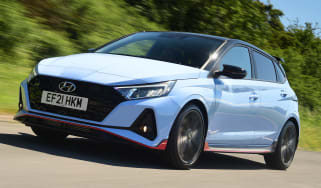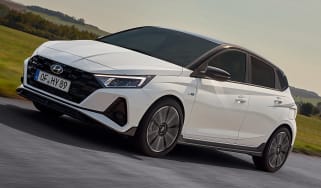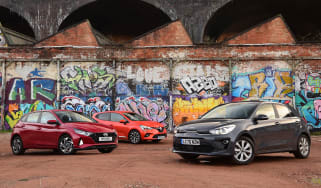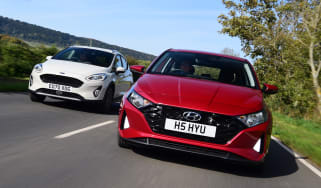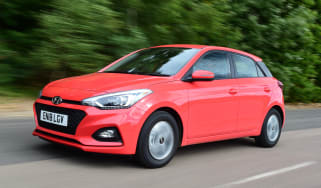Hyundai i20 review
It's not flawless, but the latest Hyundai i20 is the firm’s most competitive entrant into the supermini market yet

Our opinion on the Hyundai i20
The Hyundai i20 delivers an entertaining chassis, sweet-spinning three-cylinder engine, impressive practicality, and a high level of standard equipment. Add a strong warranty and affordable finance rates, and it looks like a compelling package.
It’s not perfect, though. The interior is let down by mixed material quality, it has a firm low-speed ride on its larger wheels, and the limited engine range might not suit all. For those reasons, we still think the Renault Clio is a better all-rounder, but the i20 is closer to the top of the class than ever before.
About the Hyundai i20
The steady march of progress continues at Hyundai, and the latest i20 is one of the best demonstrations so far of this gradual improvement – it’s the most complete i20 yet, and the closest Hyundai has got to building a supermini capable of taking on the class-leading Renault Clio, Skoda Fabia and Volkswagen Polo.
While based on the same platform as its predecessor, Hyundai has developed the car in every area. You won’t fail to notice the sharper new styling, particularly the slash-cut flanks which ape the SEAT Ibiza. All versions now come with modern LED headlights that help freshen the look; there’s a new grille, and the Hyundai badge has moved to a more prominent position near the bonnet's leading edge.
Used - available now
There have been similar advancements inside, with a more modern design and the notable application of a dual-screen set-up not dissimilar to that used in the Mercedes A-Class. Offering a fully digital instrument cluster is impressive in this class, adding a high-tech feel. Unfortunately, that doesn’t quite stretch to the interior materials, which lag behind some rivals.
We’ve driven the i20 in both pre- and post-facelift forms, however Hyundai’s revamping efforts weren’t enough to see off the Citroen C3 when the two superminis faced each other in our twin test. The i20 fell short of its French rival due drawbacks including its sluggish infotainment system and limited range of engines.
Hyundai i20 prices and latest deals
Pricing for Hyundai i20 line-up kicks off with the Advance model from £22,100. Sitting in the middle of the range is the Premium at around £23,300. At the top of the i20 tree sit two equally-priced variants: the Ultimate, which focuses more on luxuriousness, and the N-Line, which adds some cosmetic sporting flavour. Both of these are priced from around £24,800.
If you build your perfect Hyundai i20 via the Auto Express Buy a Car service, though, you can save an average of around £2,700. We also have plenty of new i20s in stock and ready to go, along with a number of used Hyundai i20 deals. We can also help you sell your car.
Performance & driving experience
Pros |
|
Cons |
|
Following a mid-life facelift for the i20, Hyundai also pared back the model’s engine line-up to the extreme. As such, there’s only one petrol motor available: a 1.0-litre, three-cylinder turbocharged unit that develops 99bhp. It’s available with a choice of six-speed manual or seven-speed automatic transmission; with the latter, peak torque is higher, standing at 200Nm compared with the manual model’s 172Nm.
Refinement is good, however. The three-cylinder unit is a little more vocal on start-up than the equivalent Stellantis engine, but it settles down nicely on the move.
Unfortunately, however, the gearbox options are an issue. The manual is extremely difficult to use smoothly, because the engine mapping cuts and re-engages the power clumsily when the clutch pedal is pressed, meaning the car feels awkward to drive around town.
Thankfully the seven-speed dual-clutch gearbox is much better; apart from occasionally being a little slow to kick down – something that engine needs to do every once in a while, given its modest power – it’s smooth and responsive. However, it’s a pricey £1,250 option.
There’s no hybrid assistance on offer here, either; some sort of clever electrical tech would at least take the sting out of the relatively high asking price, considering the underwhelming power and torque outputs.
| Model | Power | 0-62mph | Top speed |
| i20 1.0T GDi Advance | 100bhp | 11.1 seconds | 114mph |
|
I20 1.0T GDi Premium DCT
| 100bhp | 12.1 seconds | 112mph |
| I20 1.0T GDi N Line S | 100bhp | 11.1 seconds | 114mph |
Performance, 0-60mph acceleration and top speed
It’s under the bonnet where the i20 doesn’t get off to the strongest of starts. Performance is merely okay rather than outstanding; a 0-62mph time of 11.1 seconds for the manual and 12.1 seconds for the auto means that some forward planning is needed when making overtakes and accelerating along motorway slip roads. Previously, a 118bhp option of this engine was offered, which gave the i20 useful extra flexibility that it now lacks.
The i20 is a little slower than the 1.2-litre Vauxhall Corsa and 94bhp 1.0-litre Volkswagen Polo, both of which can crack the same sprint in under 10 seconds.
Town driving, visibility and parking
Superminis need to be easy to drive, and – that manual gearbox aside – the i20 is a doddle. It feels suitably compact on the road, giving the driver the confidence to squeeze through tight gaps and into very small parking spaces, while the steering is light at low speeds and the turning circle is tight. The ride is well judged, too; it’s a little firmer than the average for the supermini class, but it could never be considered harsh. Instead, it simply does a solid job of keeping the body composed and controlled over speed bumps and poor road surfaces.
Country road driving and handling
Since the Ford Fiesta departed the class, finding a supermini that even a keen driver would enjoy using has become much trickier. The i20 manages to get closer to filling that gap than most rivals. It’s helped by sweet steering, which is really well weighted and has a response that feels just right for the chassis, meaning it’s very easy to get into a smooth flow on a country road.
That firmer-than-average suspension set-up makes the i20 quite agile when turning into a corner, and it’s also resistant to body roll. Thanks to that firmness not bringing with it a crashy ride, some passengers can find the i20 more comfortable than softer options in this class, because the body doesn’t wallow from one bump to the next.
Motorway driving and long-distance comfort
For a relatively small car, the i20 feels impressively stable at high speeds, with more composure than rivals such as the Vauxhall Corsa. However, the engine again becomes its downfall, because there’s not much oomph once it’s up to the national speed limit, which makes overtaking and long motorway inclines a bit more tiring than in many of its rivals.
“Both the Hyundai i20 and Citroen C3 have a slightly fidgety low-speed ride, but the i20 is better at isolating the sound of bumps and knocks from its occupants.” - Alex Ingram, chief reviewer.
MPG & running costs
Pros |
|
Cons |
|
During a week behind the wheel of the i20 DCT auto, we averaged just shy of 50mpg. Considering there’s no hybrid assistance to boost town-driving efficiency, that’s a fairly strong return, and one which helps the car run some electrically assisted superminis very close.
Even though the engine settles down nicely at a cruise, that shortage of power compared to some rivals means that it needs to put in more effort to maintain a cruising speed; as such, we noted that it’s not quite as efficient as more powerful rivals at 70mph.
| Model | MPG | CO2 | Insurance group |
| i20 1.0T GDi Advance | 52.3mpg | 120g/km | 13 |
|
I20 1.0T GDi Premium DCT
| 52.3mpg | 126g/km | 12 |
| I20 1.0T GDi N Line S | 52.3mpg | 123g/km | 15 |
Insurance groups
Depending on the trim level, the i20’s insurance ranges from groups 12 to 15. The highest is for the N-Line S with a manual gearbox, and the lowest is for the Premium trim with a DCT ’box; the automatics sit one group lower than the equivalent manual trim.
The Vauxhall Corsa, meanwhile, starts from group 19. However, those in need of the cheapest premiums will want to look towards the Skoda Fabia, as this starts in group 4.
Tax
As with all of its supermini brethren, including the electric ones, the i20 will face Vehicle Excise Duty (VED) charges of £195 per year from years two to six.
Depreciation
Again, depending on trim, the i20 is predicted to hold onto between 47 and just under 50 per cent of its original value after three years or 36,000 miles. The sporty N-Line S is the model that maintains its value the best, which slightly offsets the fact that it’s the most expensive to buy in the first place.
This is a better showing than the Vauxhall Corsa, which only manages to retain 40 to 49 per cent over the same time period. The Vauxhall Corsa Electric suffers far worse at only 30 to 34 per cent.
To get an accurate valuation on a specific model check out our free car valuation tool…
Interior, design & technology
Pros |
|
Cons |
|
While the i20’s cabin is generously kitted out, it feels a little cheap compared with the strongest competition – and the infotainment technology is starting to show its age.
Interior and dashboard design
There’s some visual interest with the unusual four-spoke steering wheel design, vents that seem to flow into the rest of the dashboard, and a 10.25-inch digital instrument display standard to all i20s. However, there’s a depressing lack of colour used – even with the Lucid Lime interior stitching option. It’s nowhere near a Citroen C3 in terms of imagination.
Materials and build quality
Quite a few different grades and textures of plastic are used throughout the i20’s cabin, but all of it feels hard and scratchy. However, other parts, including the switchgear and the three-spoke steering wheel fitted to the N-Line S trim, look and feel more expensive than what’s on show elsewhere.
Infotainment, sat-nav and stereo
Newer Hyundais have gained slicker infotainment set-ups, but the i20 has been left behind. The loading times of its system are slow; it’s at its worst when booting up, and because you need to dive into a convoluted menu to switch off the driver-assist systems, you will have to wait a while if you want to adjust them before setting off. Button presses and swipes on the mapping screen take time to register, as well.
While the touchscreen infotainment system isn’t troubling the class best, the i20’s digital driver’s display still looks sharp and easy to read. The graphics are clear, and the design and colour scheme of the round dials alter according to the driving modes. This feature is standard on every model in the range, so even the base Advance trim feels suitably hi-tech, especially because the likes of LED headlights and rear parking sensors are also included.
“Sometimes, choosing a pick of the range is easier said than done – but for the i20 it’s a no-brainer. The entry-level Advance is so well equipped for a supermini, the majority of buyers will be satisfied putting their money there.” - Alex Ingram, chief reviewer.
Boot space & practicality
Pros |
|
Cons |
|
The i20 makes the most of its modest footprint, delivering a great mix of cabin space and boot capacity that stands up well against the most roomy options in the class.
A suite of cubbyholes makes it easy enough to stash stuff around the i20’s cabin, and we approve of the decent-sized glove box, which is far more useful than what you’ll find in a Peugeot 208 or Vauxhall Corsa. The cubby ahead of the gearlever is more than suitable for a mobile phone or two, and in Premium models and above, it comes with a charging pad.
Dimensions and size
The i20 is right in the supermini ballpark, with a length of just over four metres, at 4,065mm. It’s also 1,775mm wide (excluding mirrors), and 1,455mm high, with a 2,580mm wheelbase, 10mm greater than its predecessor. For comparison, those figures are within a few millimetres of the Volkswagen Polo.
Dimensions comparison | |||
| Model | Hyundai i20 | Volkswagen Polo | Vauxhall Corsa |
| Length | 4,065mm | 4,074mm | 4,060mm |
| Width | 1,775mm | 1,751mm | 1,765mm |
| Height | 1,455mm | 1,451mm | 1,435mm |
| Wheelbase | 2,580mm | 2,552mm | 2,540mm |
| Boot space | 352 to 1,165 litres | 351 to 1,380 litres | 309 to 1,118 litres |
Seats & passenger space
It’s hard to fault the i20’s driving position. The seat and the steering wheel each have loads of adjustment, and the mirrors are a good size, so all-around visibility is fine. A huge glovebox (required to hold Hyundai’s enormous owner’s manual...), roomy door bins and a pair of cup-holders offer decent storage options up front.
While the cheap-looking and flimsy-feeling door panels might make rear passengers wonder whether they’ve been forgotten about, there is at least plenty of space on offer. Headroom is fine – if not as generous as in the taller Citroen C3 – while knee room is excellent for a circa four-metre-long car. The seats have a fairly long squab, giving decent under-thigh support for all. The centre seat is a touch narrow – normal in a small supermini such as this – but otherwise it’s very soft and surprisingly comfortable.
Rear passengers willing to share can use the USB-C port to charge their devices – a feature lacking in rivals such as the Vauxhall Corsa. However, some alternatives hide their Isofix child-seat mounts behind plastic covers; the i20’s are behind zips in the fabric, and a bit of rummaging around within the internal cushion is required in order to locate them.
Boot space
A 352-litre load volume is among the biggest available in the supermini sector, while the space itself is surprisingly versatile, too. An adjustable floor can be set at two levels. Positioned in its highest setting, it forms a near-level platform with the rear seatbacks when they’re folded down, to the benefit of loading bulky items into the boot.
With the seats folded, there’s 1,165 litres of space available – better than in a Renault Clio or Vauxhall Corsa. Little slots in the plastic beside the seatbacks can be used to hold the belts in place when folding that rear row – a simple but very smart idea.
“The i20 matches the Citroen C3 for knee room, but is a little behind in other areas. The Hyundai’s boot is a close match for its rival’s, and an adjustable floor makes the space more versatile.” - Alex Ingram, chief reviewer.
Reliability and safety
Pros |
|
Cons |
|
When it comes to customer satisfaction, Hyundai fared okay rather than outstandingly well in our Driver Power survey. As a brand, it ranked 16th out of 31, above well established names such as Ford and Volkswagen.
The i20 scored a four-star Euro NCAP safety rating when tested in 2021. That’s disappointing given that the Volkswagen Polo got the full five-star rating when tested under the same criteria. The German car received superior marks for adult-occupant protection and safety assistance.
Hyundai’s supermini packs plenty of useful safety tech, from autonomous emergency braking, forward-collision assist, lane-keep assist and blind-spot collision warning to stability control, six airbags and an eCall system that alerts rescue services.
| Euro NCAP safety ratings | |
| Euro NCAP safety rating | Four stars (2021) |
| Adult occupant protection | 76% |
| Child occupant protection | 82% |
| Vulnerable road user protection | 76% |
| Safety assist | 67% |
Buying and owning
- Best buy: Hyundai i20 1.0T GDi Advance
It may be the cheapest model, but the entry-level Hyundai i20 is fitted with enough kit to meet the needs of the vast majority of supermini buyers. While the manual gearbox certainly isn’t the slickest to use, we’d still recommend avoiding the £1,250 automatic transmission unless you specifically require an auto.
Hyundai i20 alternatives
The i20’s facelift left the range with just a single engine choice: a 99bhp turbocharged, 1.0-litre, three-cylinder petrol, while mild-hybrid technology is also missing, which seems an odd choice to us given such technology is in use with the i20’s Peugeot 208 and Vauxhall Corsa rivals.
There are also plenty of full-hybrid alternatives like the Honda Jazz, Renault Clio E-Tech, and Toyota Yaris; all of which boast impressive fuel efficiency. Of course, there’s also an ever-increasing number of fully electric superminis to consider, such as the Renault 5, Citroen e-C3 and BYD Dolphin.
Hyundai i20 history
Hyundai i20 Mk3: 2020-present
The Mk3 Hyundai i20 arrived in 2020, and it marked a big shift in the character of the car – no longer was it a dirt-cheap bargain, because prices were now on par with many of its main rivals. There were plenty more changes, too: the Mk3 was much more fun to drive and striking to look at than previous versions. Not every trait of the older i20 generations was thrown out on the third-gen car, though – equipment levels and practicality across the board were good, and pre-facelift cars came with a selection of peppy petrol engines – with the hot i20 N being a particular highlight. Read our full Mk3 Hyundai i20 buyer’s guide here…
Hyundai i20 Mk2: 2015-2020
While not as big a leap forward as its predecessor, the Hyundai i20 Mk2 was nevertheless handily better in several areas than the Mk1 model. Practicality improved a bit, and the car was much more stylish – especially if you ignored the five-door version and went for the sportier three-door i20 Coupe instead. Like the old car, the i20 Mk2 was also well equipped and represented good value compared to some of its rivals. Read our full Mk2 Hyundai i20 buyer’s guide here…
Hyundai i20 Mk1: 2008-2014
The Mk1 Hyundai i20 arrived in 2008, and was a big improvement over the Hyundai Getz supermini that preceded it. Practicality was good for such a small car, and the combination of competitive pricing and impressive equipment levels made the i20 Mk1 a tempting value-oriented alternative to other superminis like the Vauxhall Corsa, Toyota Yaris and Ford Fiesta. A choice of petrol and diesel engines were available, and the Hyundai i20 Mk1 only came in a versatile five-door hatchback form.
Frequently Asked Questions
The Hyundai i20 is appealing for all the kit you get for your money. It’s also pretty spacious inside, and comes with a decent warranty. However, there are rivals with plusher interiors, and ones that use less fuel.





